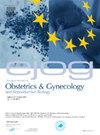妊娠滋养细胞肿瘤引起的严重子宫出血并发症
IF 2.1
4区 医学
Q2 OBSTETRICS & GYNECOLOGY
European journal of obstetrics, gynecology, and reproductive biology
Pub Date : 2024-11-13
DOI:10.1016/j.ejogrb.2024.11.016
引用次数: 0
摘要
目的妊娠滋养细胞肿瘤是一种高度血管浸润性病变,可导致严重的出血性并发症。本研究旨在描述出现子宫出血并发症的妊娠滋养细胞肿瘤患者的特征及其处理方法。研究设计本回顾性研究分析了1999年至2023年期间在法国滋养细胞疾病参考资料中心登记的2099名妊娠滋养细胞肿瘤患者的病史。结果在2099名确诊为妊娠滋养细胞肿瘤的患者中,发现38名患者出现子宫出血并发症,需要介入治疗。根据国际妇产科联盟的评分,其中 23 例(61%)为低风险肿瘤,15 例(39%)为高风险肿瘤。20名(53%)患者出现腹腔积血,18名(47%)患者出现大量阴道出血。17名(45%)患者出现子宫破裂。26名(70%)患者接受了手术治疗,6名(16%)患者接受了子宫栓塞治疗,4名(11%)患者在手术后接受了栓塞治疗,1名(3%)患者在吸宫术未能控制出血后接受了栓塞治疗。在五例死亡病例(13%)中,有一例(3%)与子宫大出血并发症有关。结论目前尚无处理严重子宫出血并发症的既定指南。介入放射学资源的可用性允许更多地使用保留生育力的手术,并在后续妊娠方面取得令人鼓舞的结果。本文章由计算机程序翻译,如有差异,请以英文原文为准。
Severe uterine haemorrhagic complications from gestational trophoblastic neoplasia
Objective
Gestational trophoblastic neoplasia are highly vascularized infiltrating lesions that can lead to severe haemorrhagic complications. The aim of this study was to describe the characteristics of patients with gestational trophoblastic neoplasia who experienced uterine haemorrhagic complications, and their management.
Study design
This retrospective study analysed the histories of 2099 patients with gestational trophoblastic neoplasia registered at the French Reference Centre for Trophoblastic Disease between 1999 and 2023.
Results
Among 2099 patients with a confirmed diagnosis of gestational trophoblastic neoplasia, 38 patients who experienced uterine haemorrhagic complications requiring interventional treatment were identified. Among them, 23 (61%) had a low-risk tumour and 15 (39%) had a high-risk tumour according to their International Federation of Gynecology and Obstetrics score. Twenty (53%) patients experienced haemoperitoneum and 18 (47%) patients experienced massive vaginal bleeding. Seventeen (45%) patients experienced uterine rupture. Haemorrhagic treatment consisted of surgery for 26 (70%) patients, exclusive uterine embolization for six (16%) patients, embolization followed by surgery for four (11%) patients, and embolization after failure to control bleeding by aspiration for one (3%) patient. Of the five deaths (13%), one (3%) was related to the uterine haemorrhagic complication. Three of 15 (20%) patients treated conservatively reported subsequent pregnancies.
Conclusion
There are no established guidelines for managing severe uterine haemorrhagic complications. The availability of interventional radiology resources could allow for increased use of fertility-preserving procedures, with encouraging results regarding subsequent pregnancies.
求助全文
通过发布文献求助,成功后即可免费获取论文全文。
去求助
来源期刊
CiteScore
4.60
自引率
3.80%
发文量
898
审稿时长
8.3 weeks
期刊介绍:
The European Journal of Obstetrics & Gynecology and Reproductive Biology is the leading general clinical journal covering the continent. It publishes peer reviewed original research articles, as well as a wide range of news, book reviews, biographical, historical and educational articles and a lively correspondence section. Fields covered include obstetrics, prenatal diagnosis, maternal-fetal medicine, perinatology, general gynecology, gynecologic oncology, uro-gynecology, reproductive medicine, infertility, reproductive endocrinology, sexual medicine and reproductive ethics. The European Journal of Obstetrics & Gynecology and Reproductive Biology provides a forum for scientific and clinical professional communication in obstetrics and gynecology throughout Europe and the world.

 求助内容:
求助内容: 应助结果提醒方式:
应助结果提醒方式:


